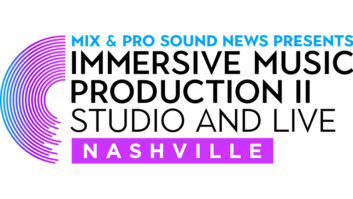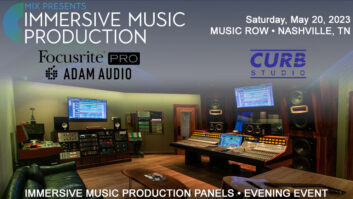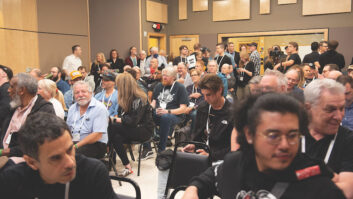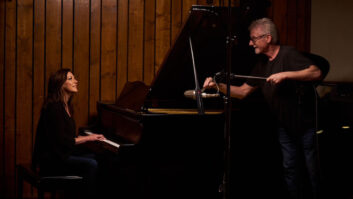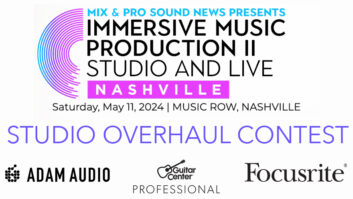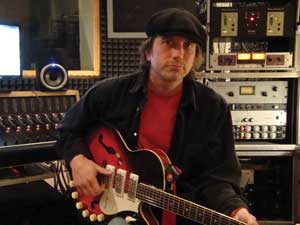
Guitarist/producer Doug Lancio at his new East Nashville studio
The Trident and the Studer were under blankets, taking up space in Patty Griffin’s Austin home. “She called me, and said, ‘I want this stuff out of my house,’” says Doug Lancio, who plays guitar for Griffin, John Hiatt and others, and has produced works for Griffin, Matthew Ryan, Todd Snider, Gretchen Peters and more. “I said, ‘Hey, I want it out of your house, too.’”
And so, Lancio and friend Bruce Mackay flew out of Nashville on New Year’s Eve of 2008, rented a truck, drove to Griffin’s house, loaded gear into the truck and drove back to Nashville. By 10 a.m. on the first day of 2009, Lancio had the pieces to complete the studio that he was opening. He and Griffin had gone in together on some property on Chapel Avenue in East Nashville, down the street from the spot where Townes Van Zandt wrote “If I Needed You,” and now there was a Trident 324 board and a Studer A827 analog tape machine and two Telefunken V76 preamps and some other niceties for the new place.
“I had a home studio that I’ve now moved out of the house, and now there’s Patty’s home studio that she had in her house,” Lancio says. “We found a room, and we put our gear together, and now it’s at the next level.”
Lancio’s history involves taking things to the next level. He recorded Griffin’s 1000 Kisses album on a 16-track Roland digital studio-in-a-box, and mixed most of it in the box, as well. Lancio became interested in producing and engineering shortly after his first major band, The Questioners, somehow spent more than $300,000 on a debut record. A four-piece rock band, they recorded drums one at a time: snare at once, then kick at once, then a floor tom, then a ride cymbal, etc. Lancio figured there might be a better way, and he wound up building a basement studio where he recorded music for Griffin, Snider, Robinella, The Greencards and a slew of others.
“Well, that was until my boy, Rufus, turned 2,” he notes. “If you listen to those records, they all sound really quiet, like the baby might be sleeping upstairs. That’s because the baby was sleeping upstairs. And now he’s bigger, and it’s less and less possible to record that way. So this new place is also about getting out of the house. I see myself working more with bands now. In the house, it was primarily singer/songwriters.”
The “new place,” as yet unnamed, shares a roof with the studio owned by Larry Hanson, longtime member of the band Alabama, whose daughter, Jennifer Hanson, has become a well-known country singer. When Larry Hanson isn’t working, he offers up his three Hammond organs and his space, doubling the size of Lancio and Griffin’s music lair.
Even without the Hanson add-ons, Lancio’s studio has three isolation booths and an ambient tracking room with a 25-foot ceiling. He tracks through the Trident — a John Oram-made model of recent vintage — often recording vocals on a 1952 Neumann M49 that he calls “fat and warm.” And, while he says there’s always room to experiment, Lancio often uses a few tricks he’s discovered.
“I’ve got a way I like to record drums, really old school,” he says. “Only three mics: a Coles ribbon centered above the kit about seven feet up, a Shure SM57 set about 10 inches below the snare and pointed up, and a bass drum miked on the outside of the head. I stole this from Hiatt, and he stole it from The Beatles.
“I also like to use a bass drum with no front head and a second bass drum with both heads in front of the drum being played,” Lancio continues. “Just throw a blanket over both drums and place the mic inside the second drums, and it helps to create an airy, big, cushy sound. The top mic on the kit will have all the attack, ‘toppy’ stuff. It works very well with a light touch on the foot: more tone.”
Lancio also has a preferred method for recording harmony vocals.
“I get the background singer or singers to step away from the mic,” he says. “Try positioning any singers you add while overdubbing as if the singer who sang previously is still standing there at the mic. Remember how great those records sound where it had to be done live, around one or two mics? I try to mike things from a distance that I’d like to have them in the mix. The same theory applies to capturing your main picture of the drums from one or two mics — the drummer winds up controlling the mix of his instrument.”
Griffin has first dibs on recording at the studio, though her Austin locale means that Lancio often records others in the just-opened space. He tours with Griffin and in Hiatt’s band, but there is plenty of off-time and he fills it with sessions. Though the Studer is up and running, he also records through the Trident to digital.
“I don’t have a Website or anything, but I do have a lot of people who find me,” he says. “I’m not sure how they find me, but they do.”
Anyone interested in finding out more about Lancio and his new studio june e-mail him at [email protected].
Reach Nashville Skyline by e-mailing
peter@petercoopermusic.

